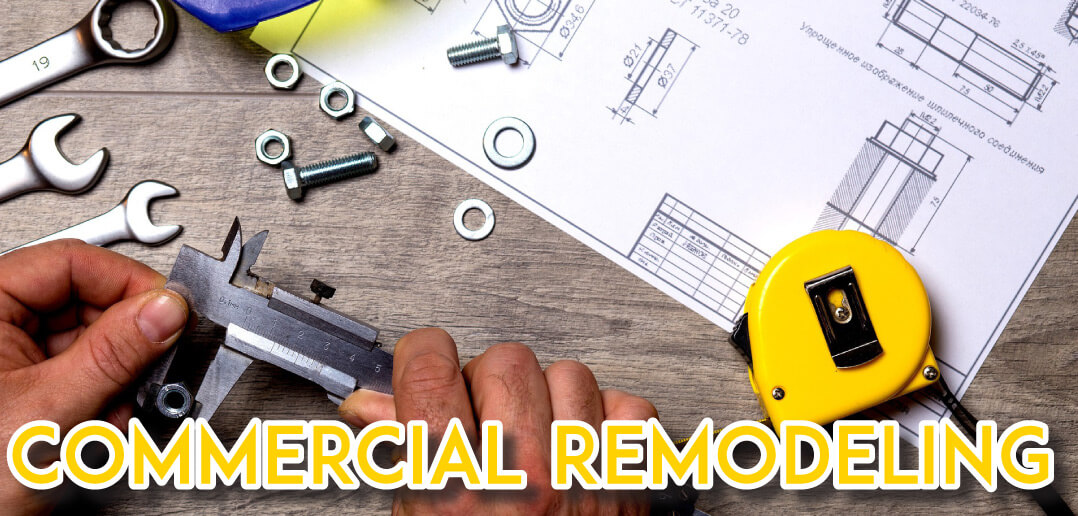Commercial Remodeling in Lincoln, NE – 2018
We’re all familiar with the significant uptick in construction this time of year, with new buildings going up all around town. Of course, who could miss all of the dreaded “Road Closed” and “Road Work Ahead” signs either? Not as visible unless you get to see the before and after, it’s also a great time to take on a remodeling project. In yet another installment of our annual two-part series, this month we’ll be covering commercial remodeling projects, and then next month, we’ll focus on residential remodeling projects.
So, you’ve taken stock of your surroundings it’s time for some improvements to your place of business. Commercial remodeling projects run the gamut from replacing the flooring or repainting the walls to completely gutting a building or a new build-out. It could be focused on the interior, exterior storefront and property improvements, or both. There are of course the design elements that you can see, but also equipment and systems that you don’t see that play a starring role in the building functioning properly behind the scenes and may be due for an upgrade. Some projects involve restoration, such as the renovation of historical buildings, which are especially prevalent in Havelock, downtown Lincoln, and the Historic Haymarket business districts.
Project Phases
Your project will go through certain phases, during which time specific processes will take place. In the traditional project management model, this includes:
Initiation: Exploration of an idea with the goal of examining the feasibility of the project.
Definition: Requirements associated with the project result are specified as clearly as possible, including identifying expectations of all parties.
Design: One or more designs are developed, which is/are used to choose the definitive design that will be produced.
Development: Everything needed to implement the project is arranged and in place.
Implementation: Just like it sounds, the construction process.
Follow-up: Anything else that needs to be arranged to bring the project to completion, such as arranging a maintenance schedule or even hosting a grand (re)opening party!
As you go through the various phases, Rod Berens with Kingery Construction offers the following advice:
“When planning, you’ll be carefully considering the intended use(s) of your space and based on those specifics, how you’ll be enhancing or repurposing it. At the same time, incorporating features into the overall design that allow for flexibility, or flex space, is advised in modern workspaces. For example, there are a lot of really nice portable partitions/walls on the market today that allow you to reconfigure your space. That being the case, you could knock out the walls to open the space up, but you’d still have the option to section it off later if you choose without undergoing construction again.
For larger-scale projects, having an architect and a general contractor on board from the beginning is advised. By applying the expertise of both, you’ll be able to fully explore the possibilities from the two different perspectives. This way, you’ll end up with plans that have great design elements on the creative side but that have also undergone an edit process to eliminate anything that is problematic from a production standpoint, which helps to minimize redesign costs. As far as referrals for both, don’t just go with whichever one is recommended. Instead, do your research on that one and a few others, check out their past work, talk to them to get a feel for how it would be working with them over a lengthy period of time, and decide for yourself.
Remodel work can be a lot more difficult than new construction because there are a lot of unknowns when you get into the project. We enjoy that challenge and have found that to be one of our specialties. With a portfolio of work that includes a wide variety of projects, we’ve got a lot of expertise to offer. Furthermore, our average length of employment is 18 years, and close to 25 years in certain industries, so we are fortunate to have seasoned professionals with a great deal of experience on our team. This has allowed us to take on some very difficult projects over the years. Right now, we’re involved in a lot of large-scale projects that involve building additions. No matter what your project entails, my advice is to work with someone who has experience and demonstrated success with similar projects. Many contractors have niches or tend to gravitate towards certain projects, whether it’s government, schools, restaurants, retail, historic buildings, etc. In order to avoid a scenario where your contractor is trying to figure things out as they go, it’s ideal to select a company that’s done the type of project you’re looking to do before, and the more times, the better.”
In closing, he particularly stresses, “Make sure you have a good set of working plans and specifications to avoid delays and additional costs. Also, exercise caution when attempting to cut corners or skimp on things to save money in the planning stages. Oftentimes in doing so, you’ll just end up spending a lot more later on down the line. It could be during the process when you have to make changes, which may involve different products that require lead time to order and receive, holding everything up in the process. Or, it could be afterward when wear and tear requires replacement earlier than it would with a higher quality product, and you might have to go through the construction process all over again that could involve downtime for your business. Get a good set of plans and specs, involve your contractor in the planning process, and make the important decisions early on so that everything goes as smoothly as possible and you get exactly what you want out of the finished product.”
Getting bids to decide who to select for a project based on cost is common, and it’s wise to exercise caution with that process as well.
Jon Eicher with ABC Electric explains, “While very important, project cost is not always the best method of determining which contractor or subcontractor to choose. What may seem like a great deal or a low price upfront may actually turn out to be a costly long-term decision. We believe that our experience and attention to detail will ultimately give the owner more ‘bang for their buck’ over time. Therefore, I always recommend working with a ‘known entity.’ This is someone who has a proven track record, has an excellent rating with the Better Business Bureau, and can provide references that you are welcome to contact. ABC Electric is a family-owned local business with more than 85 years of continuous service to the community, spanning four generations. We are qualified to perform any and all electrical service you may require and we are responsive and conscientious. Our success is, and has always been, measured by that of our customers. Companies that are confident in their work and living up to the expectations of their customers will be transparent and up-front about the details during the planning stages, will follow-through with their performance on the job, and will stand by their work afterward.”
There are also different construction delivery methods to consider. “Understanding the variations in construction delivery methods is extremely important before selecting one for a construction project,” advises Justin Kurtzer with Cheever Construction. “While there are many different types of delivery methods, the three most often utilized include Design-Bid-Build, Construction Management with variations, and Design Build. Selecting the correct delivery method can have a direct impact on the outcome of the project. Numerous items will factor into your decision, including size of the project, complexity of the project, project type, and overall delivery schedule.”
Decisions, Decisions
Back to the topic of budget, depending on the constraints that are present, it can often be tough to choose which upgrades should be made first and which can wait. By looking at the big picture, it will help you make those decisions based on investing in projects with the most justifiable returns.
While oftentimes a significant investment upfront, increased energy efficiency is a common theme of contemporary upgrades being made to commercial spaces because of its distinct benefits. From lighting solutions to building automation technology, there’s a lot of potential here.
“By far, anything considered ‘green’ should be a prime target for commercial remodel work,” emphasizes Pat Killeen with Engineered Controls. “In fact, many of our clients are building owners and managers who are looking for help in developing reliable and cost-effective solutions for their specific energy challenges and reducing their carbon footprint.
Our Building Services group can provide responsive retrofit and energy solutions direct to building owners for those seeking to reduce their energy consumption and improve the performance of their building. Over the past several years, Engineered Controls has performed many large owner-occupied environmental controls, building automation, and security system retrofit projects with minimal disruption to their employees or the tenants of the facility. First, we work with you and your staff to determine the age, equipment status, and present energy efficiency of your building. Then we analyze your existing energy usage and suggest the most cost-effective solution that meets your utility goals.
There are quite a few possibilities for upgrades that could be incorporated to accomplish the goal of increased energy efficiency while also yielding other significant benefits.
A building’s mechanical systems can be optimized by providing supply air and supply water reset programs, automatically adjusting the temperature of the air or water depending on space demands and outside air temperatures. Mechanical optimization programs could also include demand control ventilation programs to provide the right amount of outdoor air required in the building to improve the indoor air quality. Additionally, constant volume air and water systems can be converted to variable air and water flow systems, delivering just the right amount of air and water based on demand.
Regarding a building’s electrical systems, there are a whole host of ways a BAS can optimize electrical energy in buildings. The simplest and most recognized way is to monitor a building’s electrical energy usage. For most buildings, electricity is billed two ways: electrical energy consumption (kWh) or the peak electrical energy usage over a specific period of time (kW demand). A BAS has time-based scheduling programs that can be used to minimize the electrical consumption of a building. At the same time, it can also be constantly monitoring the building’s kW demand and as it begins to approach a predetermined peak demand, begin shedding or shutting off electrical loads automatically.
All of these mechanical and electrical optimization solutions are designed to maintain building comfort and maximize energy savings that result in reduced energy bills.”
Along the same lines, you’ve probably heard of smart home technology, and much of the same features are being used in commercial buildings as well. Killeen explains, “Today buildings of any size and shape can become intelligent buildings. With open protocol technology, multiple subsystems can be connected together, on one network, rather than operating them all independently. This maximizes energy efficiency, lowers maintenance costs and provides centralized building control.
Building automation systems provide efficient control of internal comfort conditions, individual room control, increased staff productivity, effective use of energy, improved building reliability and life, quick and effective responses to HVAC and security problems, and save time and money. The systems also provide information on problems in the building, allow for computerized maintenance scheduling, are easy and effective for employees to use, and swiftly detect issues when they arise.
By integrating heating and cooling, lighting and security functions all within one common BAS platform, a building’s power systems; lighting and illumination; electric power and control; security, video surveillance and magnetic card access; heating, ventilation and air-conditioning systems (HVAC); outdoor controls; and elevator controls will all be monitored and controlled from one central location.
While building automation systems have been around since the late seventies and early eighties, the addition of wireless technologies and the integration of wired and wireless systems are driving the market forward. There is a great demand for energy efficient buildings, high-tech devices, and enhanced security systems that are now a central component of the building automation system. Wireless technology will continue to revolutionize the BAS market.”
As with outdated systems and features that are no longer serving a business well, more often than not, improved use of space or the need for more space are key factors that influence the decision to undergo renovations.
Within that overarching theme, not having enough storage space is a common problem. It can be addressed by adding more square footage or finding a place in the existing area to repurpose, but there are other ways around that too.
Levrack is a unique storage system that is clean, efficient and durable, making it perfect for commercial and industrial spaces. As with many of the greatest products on the market, it was developed to solve a real-world problem that its inventors were experiencing – the need for a storage system in their shop that helped them efficiently use their space, minimize clutter, and not take up much-needed wall space. They came up with the perfect system that addressed all of the problems they’d identified and put Levrack on the market for others to use in their garages, shops, and businesses.
“When space is at a premium, you need it to be usable and to maximize what you’ve got to work with,” says Austin Peters with Levrack. “When planning to remodel, you’re thinking about things like how you can improve upon use of space, organization, employee efficiency, etc. When you’re deciding how to go about this, consider Levrack, which acts as a mini storage facility. It hides everything from sight, which allows you to keep the appearance of your business clean and presentable. You can store things on top and inside, and you’d be amazed at how much one can hold.”
Contractor Corner
Now let’s switch the focus from the client who would be looking to remodel to the contractors who work on these projects. If you’re reading this and you’re a local contractor, we’ve got a proposition for you to consider. Have you heard of FleetRight, which based on a recent merger is now Never Idle? This is a company building a dynamic marketplace where their Contractor-Only Network gains personal, financial, and performance benefits from renting and selling equipment. “Our clients lend their idle assets, and by renting them out, they are still getting a return on their investment while they are not using them for a revenue-generating project,” says Zach Schreiber with Never Idle. “Based on the research we conducted, contractors with a minimum inventory of 50 units have on average 20-30% of that equipment sitting idle. These units may be idle for a few days, weeks or even months at a time. We developed our offerings after speaking to thousands of contractors as we looked into a way we felt we could help them improve their bottom line. Their concerns were what we suspected – rising costs of new equipment, rising rental rates with fewer businesses focused on heavy earthmoving equipment, having no choice other than to buy highly-specialized equipment that isn’t offered by a rental company, and there not being a simple method to sell and/or rent their equipment to other contractors. Now with Never Idle, your valuable equipment can be put to use and earn you money instead of sitting idle waiting for the next job. With our growing community of contractors, there’s access to a tremendous number of units across the region that are more likely to be configured just right for your job and closer to your job site than traditional channels. Furthermore, the cost to rent these units can be approximately 30% less, improving your operating costs for jobs. It’s a win-win for contractors on both sides of the deal.”
He also notes, “If you’re the owner of the asset, you’re probably worried about it being in good hands. Never Idle has developed a proprietary app and process to ensure the condition of the unit is captured and both parties are in agreement about it at the time of rental, and a record of that is maintained. Similar to car rental, this allows us to manage responsibility for any damage that occurs while the unit is being rented beyond normal wear and tear. You might also be worried about pricing, and those who provide the asset are in complete control over that, just name your price and negotiate if you like. We’re proud of the steps we’ve taken to make renting, and selling, your equipment simple.”
To sum things up, whatever you’ve got in store for your place of business, or whatever you need for your next project, there’s a local expert that can help you turn your vision into a reality.







